Wheelchair athletes can excel in archery with specialized adaptive gear. You’ll benefit from adjustable bow mounts that attach directly to your chair, advanced release aids for limited hand function, and customized seating systems for stability. Consider specialized stabilizers to counter chair balance issues, strapping systems for positioning security, and precision sighting equipment designed for seated shooting. Paralympic-compliant modifications guarantee competitive eligibility while all-terrain wheelchair options expand your shooting locations. Discover how this equipment can transform your archery experience.
Essential Wheelchair-Compatible Bow Rests and Mounts
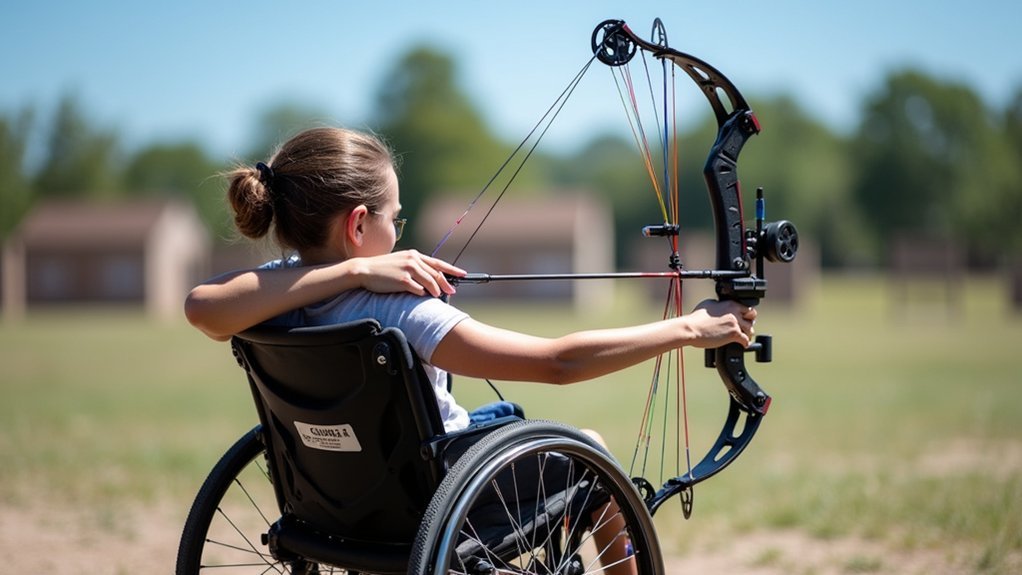
Innovation in adaptive archery has revolutionized the sport for wheelchair athletes. When selecting bow mounts and rests, you’ll need equipment that provides stability without compromising your shooting technique.
Look for adjustable mounts that accommodate your specific bow type—whether compound or recurve. The best options feature simple mechanisms that you can operate independently, even with limited hand function.
Wheelchair-attached stands offer stability for precise shots, while freestanding alternatives provide flexibility in your shooting position. Premium wheelchair mounts are designed to support the entire weight of your bow, allowing archers with limited strength to focus on aiming rather than holding the equipment.
Quality bow rests enhance accuracy and safety by ensuring proper arrow alignment. Brands like Hamskea Archery and Trophy Taker offer solutions with universal brackets that adapt to various setups.
Advanced Release Aids for Limited Hand Function
While standard archery equipment often requires significant grip strength, advanced release aids have transformed accessibility for wheelchair athletes with limited hand function.
These innovative devices offer customizable solutions that you’ll find invaluable for competitive or recreational shooting.
When selecting a release aid for your specific needs, consider these options:
- Wrist strap releases with index finger triggers – perfect if you have partial hand function but limited grip strength.
- Back tension-style hinges – eliminate the need for finger dexterity by activating through tension changes.
- Mouth tab systems – customizable in various materials for those with minimal arm function.
- Elbow strap mounts – ideal solutions when missing parts of your arm, allowing secure attachment to existing limbs.
Some Paralympic archers use specialized release aids mounted on a custom back brace that activate through biting mechanisms connected to bike brake cables.
Regular practice with your chosen release aid guarantees both safety and improved performance.
Customizable Seating Systems for Optimal Shooting Position
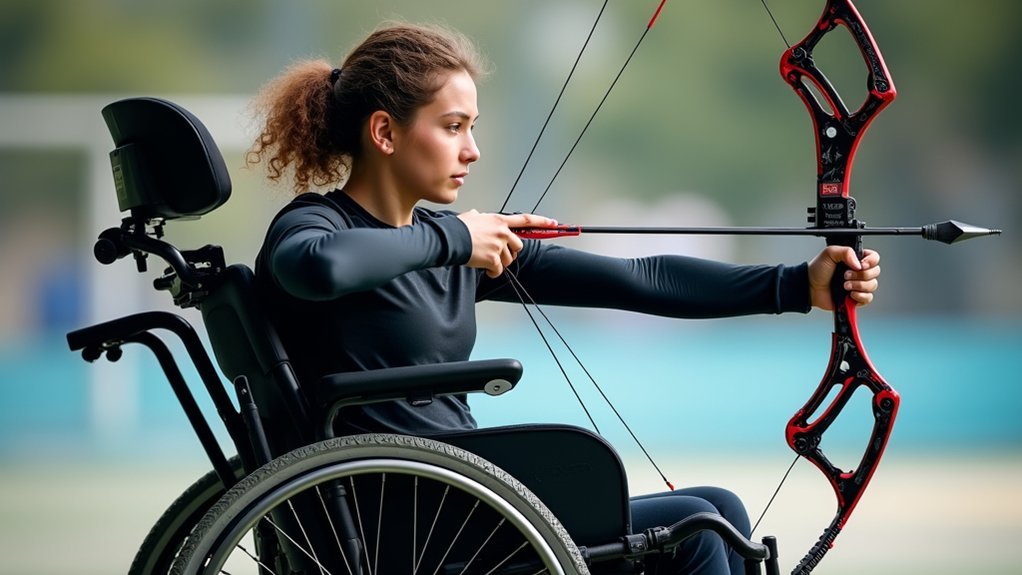
Beyond specialized release aids, proper positioning forms the foundation of successful adaptive archery. When you’re shooting from a wheelchair, you’ll want to straddle the shooting line with wheels positioned on either side for maximum stability.
Made-to-order seating systems address everything from basic to complex needs with adjustable, expandable components that accommodate your unique body type and shooting style.
These systems integrate seamlessly with your existing wheelchair while providing essential stability for maintaining accurate aim. These customized solutions are fabricated to measurements ensuring a precise fit for each athlete’s specific requirements.
You’ll benefit from improved comfort during extended shooting sessions and enhanced shot consistency that can give you a competitive edge.
Look for solutions from manufacturers like JAY, consult with archery pro shops about equipment integration, and work with para-archery coaches to determine your ideal seating configuration.
Specialized Stabilizers and Counterweights for Chair Balance
As you perfect your adaptive archery technique, specialized stabilizers and counterweights become essential for achieving balance and accuracy from your wheelchair.
These components work together to minimize torque, absorb vibration, and maintain your chair’s stability during shooting. Reduced torque contributes significantly to accuracy by preventing unwanted bow movement during release.
When selecting your stabilizer system, consider these key options:
- Dual stabilizer setups provide multi-directional balance critical for seated shooting positions.
- Offset stabilizers help automatically level your bow, reducing shot time and compensating for limited arm positioning.
- Sidebar stabilizers prevent lateral bow movement, reducing left/right misses common in wheelchair archery.
- Adjustable counterweight kits allow you to fine-tune your bow’s center of gravity without compromising your wheelchair’s stability.
Lightweight aluminum alloy components offer the ideal balance between durability and portability while preventing excessive strain on your seating system.
Bow Modifications That Meet Paralympic Standards
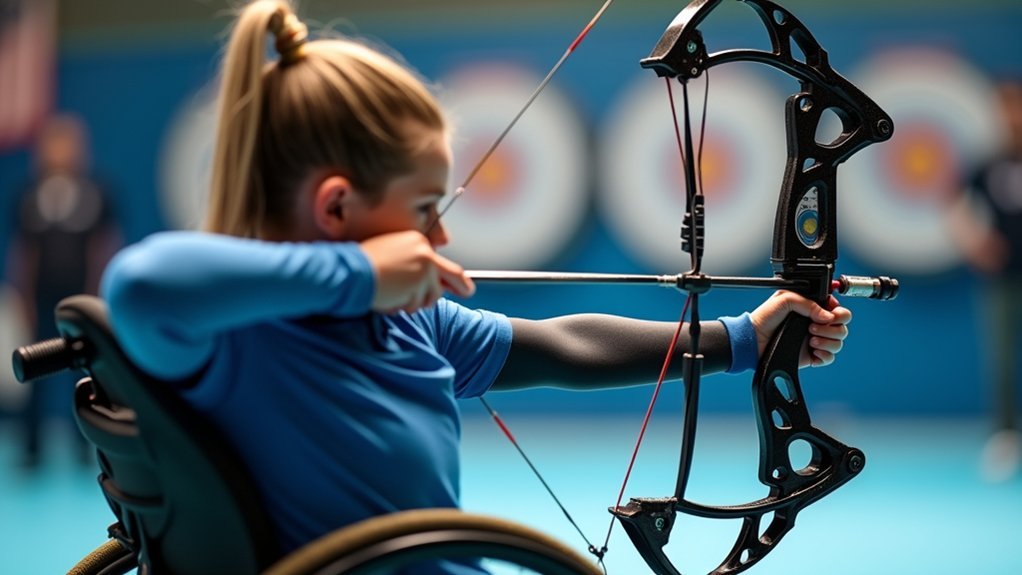
Having the right stabilizers for your wheelchair setup is just one part of the equation. Your bow itself can be legally modified to accommodate your specific needs while still meeting Paralympic regulations.
All modifications must be justified by your impairment level without providing performance advantages. World Archery requires bow adaptations to be documented and pre-approved before competition. Adaptive equipment usage is guided by USA Archery’s comprehensive policy to ensure fair competition.
| Modification Type | Allowed Uses | Requirements |
|---|---|---|
| Release Aids | For grip/finger impairments | Must match classification assessment |
| Bow Supports | Stabilizes during aiming | Cannot create mechanical advantage |
| Riser/Limb Adaptations | Limited hand function | Custom-built to match mobility range |
Remember that assistants for arrow nocking are only permitted for W1 or ST class athletes with severe upper limb disabilities. Your chair’s back support must also remain at least 110mm below your armpit during shooting.
Adaptive Quivers and Arrow Retrieval Solutions
Wheelchair archers often struggle with traditional quivers that were designed for standing shooters. Specialized adaptive quivers and arrow retrieval systems can greatly improve your shooting experience and performance.
You’ll find several options to enhance your accessibility:
- Wheelchair-mounted quivers attach directly to your chair for improved stability and easier access, with adjustable positions to match your specific needs.
- Mechanical retrieval systems let you collect arrows without leaving your shooting position, reducing fatigue during practice sessions.
- Integrated quiver-bow stands provide a thorough solution that keeps all equipment within reach while maintaining proper positioning.
- Easy-access quiver openings feature ergonomic designs with simple mechanisms that accommodate limited dexterity, making arrow placement effortless.
These adaptive solutions help break the stigma associated with disabilities while enabling full participation in the sport of archery.
Strapping Systems and Lateral Supports for Safety

Your wheelchair’s strapping systems must comply with competition regulations while providing the stability you’ll need for accurate shooting.
Lateral supports prevent sideways falls by securing your torso without protruding beyond half your ribcage width at mid-back level.
You’ll find customizable anchoring solutions available through specialized vendors or medical supply stores, with options ranging from simple 5 cm straps to extensive support systems designed specifically for your classification category. Be sure to review the complete “Rulebook” for detailed guidance, as it contains essential archery standards that apply to adaptive equipment.
Crucial Positioning Security Features
When safety and stability converge in adaptive archery, proper positioning security features become essential for wheelchair athletes.
You’ll need to understand both strapping systems and lateral supports to maintain your position while shooting effectively.
- Strapping Requirements – If you’re classified after 2021, you can only use strapping if it’s specified on your classification card and serves a medical or safety purpose rather than enhancing performance.
- W1 Classification Flexibility – As a W1 athlete, you’re permitted to use unlimited strapping for body stability provided it doesn’t support your bow arm.
- Lateral Support Integration – Combine strapping with lateral supports to prevent wheelchair movement during your shot sequence.
- Safety Compliance – Verify your footplates don’t contact the ground and anti-tipping devices are properly installed without touching the shooting surface.
Fall Prevention Technology
Fall prevention technology forms the foundation of safety for wheelchair archers, combining specialized strapping systems with lateral supports to guarantee stability during competition. You’ll find these systems designed to secure your position without providing assistance to your bow arm. Since March 2022, W2 archers are now permitted to use lateral support within specified dimensions, greatly expanding equipment options for these athletes.
| System Type | Function | Classification Requirements |
|---|---|---|
| Non-Rigid Supports | Provide body stability without bow arm aid | Must be documented on classification card |
| Lateral Supports | Attach to wheelchair for enhanced stability | Customized to disability classification |
| Anti-Tipping Devices | Prevent wheelchair movement during shooting | Must not contact ground during competition |
| Corset-type Straps | Maintain proper posture | Permitted for W1 classification athletes |
These technologies not only keep you safe but improve your performance by letting you focus on technique rather than stability concerns. All systems must comply with World Archery regulations.
Customizable Wheelchair Anchoring
Customizable wheelchair anchoring systems form the critical foundation of both safety and performance for adaptive archers, balancing necessary stability with competition regulations.
Your classification determines permissible equipment, with W1 athletes allowed unlimited strapping while W2 competitors face more restrictions.
When selecting your anchoring system, consider these key components:
- Leg straps (maximum 5cm wide) can be applied at ankles, knees, or mid-thigh for stability.
- Lateral supports must extend no more than half your ribcage width to prevent sideways falls.
- Anti-tip devices prevent backward tipping but shouldn’t touch the ground during competition.
- Body supports like non-rigid corsets can complement your strapping system for enhanced torso stability.
Precision Sighting Equipment for Seated Archers
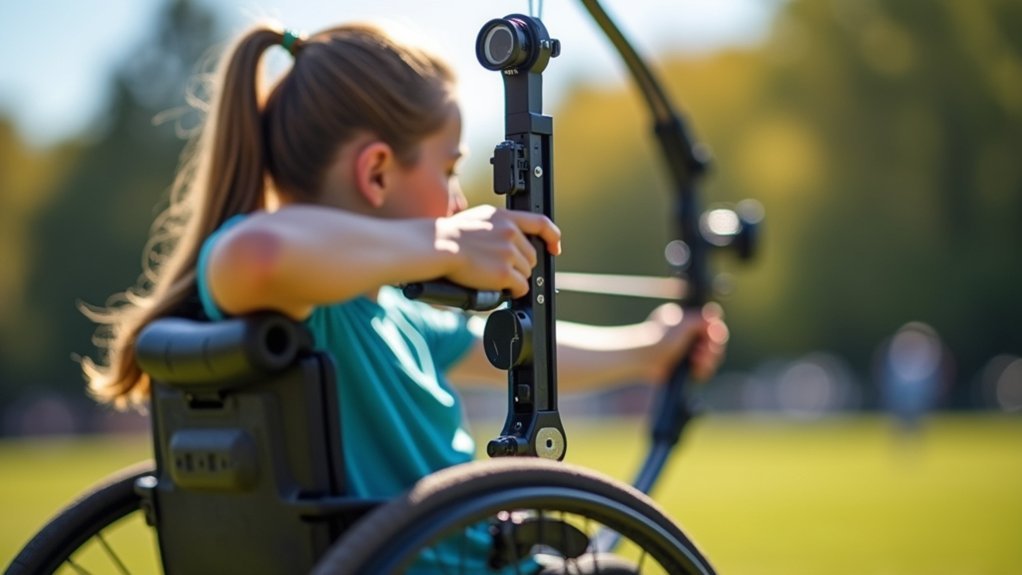
The precision sighting equipment available to wheelchair athletes has revolutionized adaptive archery, bringing professional-level accuracy within reach for seated competitors.
Ultralight peep sights with tapered interiors provide superior sight pictures while adding minimal weight to your setup.
You’ll find rifle-like “no-peep” sighting systems especially valuable, as they offer enhanced accuracy from your seated position.
These can be paired with interchangeable apertures to adapt to varying light conditions and anti-glare coatings for shooting in harsh sunlight.
For maximum precision, consider sighting systems with magnification options that improve target visibility at longer distances.
Most of these systems feature adjustable viewing angles to accommodate your specific wheelchair setup, ensuring you can maintain ideal sight alignment throughout your shooting session.
Many adaptive archers are now utilizing software like Precision Cut Archery that employs proprietary algorithms for creating perfect sight tapes tailored to their specific equipment.
All-Terrain Wheelchair Options for Field Archery
You’ll need a wheelchair that conquers rough terrain if you’re serious about field archery beyond paved ranges.
All-terrain models feature robust wheels, enhanced suspension systems, and adjustable configurations that provide stability during shooting on uneven ground.
For maximum accessibility, look for chairs with track systems or oversized tires that handle mud, sand, and rocky paths while maintaining the balance necessary for accurate shots. These specialized chairs are particularly beneficial for ARW2 category competitors who rely completely on wheelchair mobility due to lower body paralysis.
Off-Road Chair Features
Field archery enthusiasts who use wheelchairs need specialized equipment that can handle rugged outdoor conditions while providing stability for accurate shooting.
Today’s all-terrain chairs offer innovative features designed specifically for archers traversing challenging environments.
- Three-wheel configurations provide superior weight distribution and stability on uneven terrain, with large 24-inch wheels that roll over obstacles encountered during competitions.
- Carbon fiber frames reduce overall weight while maintaining strength, helping conserve energy during long archery events.
- Patented shock absorption systems protect both archer and equipment from impacts, maintaining comfort and shooting precision.
- Electric motor options with 3.4 horsepower PMDC motors give archers greater range and reduced fatigue, though designs guarantee no assistance to the bow arm during shooting to comply with competition regulations. Many of these chairs are compatible with the ARW2 category where athletes have complete paralysis in the lower body but maintain upper body function.
Terrain Accessibility Solutions
While standard wheelchairs meet basic mobility needs, they often falter when archers venture onto the varied terrain of field archery courses. All-terrain wheelchairs bridge this gap with heavy-duty frames and specialized tires designed to navigate mud, snow, sand, and uneven ground.
Look for models with adjustable suspension systems that absorb shocks from rough terrain, improving your shooting stability. The best options balance ground clearance with a stable shooting platform—crucial for maintaining accuracy in field conditions.
Many chairs feature power-assist capabilities or optimized manual propulsion to help you traverse longer courses without fatigue. Specialized seating systems guarantee proper posture for extended shooting sessions. The Action Trackchair® offers patented tilt design that allows archers to customize their seat angle for optimal shooting position.
These accessibility solutions have transformed mountain 3-D archery into an inclusive sport through collaborations with rehabilitation centers and charitable foundations.
Frequently Asked Questions
How Do Temperature Changes Affect Adaptive Equipment During Outdoor Competitions?
Temperature changes can make your adaptive equipment brittle when cold or warp when hot. They’ll affect string tension, metal parts’ expansion, and release mechanisms. You’ll need regular adjustments to maintain accuracy during outdoor competitions.
Can Adaptive Archers Compete Alongside Non-Disabled Archers in Standard Tournaments?
Yes, you can compete alongside non-disabled archers in standard tournaments. While regulations vary, many events welcome adaptive archers with appropriate classifications and equipment. Check tournament rules for specific accessibility accommodations before registering.
What Insurance Considerations Apply for Clubs Hosting Adaptive Archery Programs?
You’ll need extensive insurance including general liability, accident coverage, and equipment insurance. Verify that your policies specifically cover adaptive programs and participants. Contact specialized providers like USA Archery or Sadler Sports for guidance.
How Often Should Classification Reassessment Occur for Progressive Conditions?
You should undergo classification reassessment annually for progressive conditions. However, if you notice significant changes in your ability, don’t wait—request immediate reassessment to guarantee you’re competing with appropriate adaptations and classification.
What Psychological Adaptations Help Wheelchair Athletes Maintain Competition Focus?
You’ll maintain competition focus through mental toughness, individualized coping strategies, self-awareness, and positive perception. You’re strengthened by resilience from overcoming unique stressors, while using social support networks to navigate psychological challenges effectively.
In Summary
You’ve now got the ultimate guide to adaptive archery equipment that’ll transform your wheelchair archery experience. Whether you’re just starting out or training for Paralympic competition, these specialized tools will help you optimize your form, improve accuracy, and shoot with confidence. Remember, the right gear isn’t just about performance—it’s about creating an accessible, enjoyable sport that you can participate in with independence and precision.

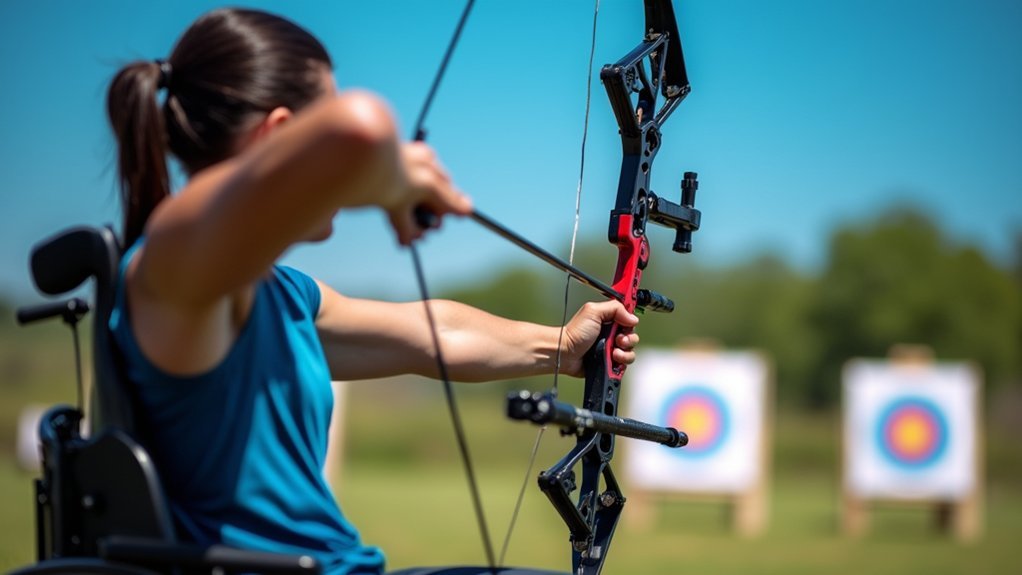



Leave a Reply